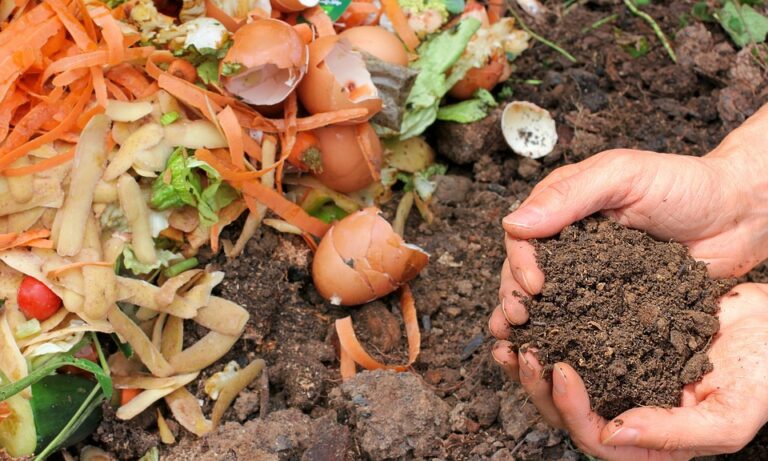5 Innovative Ways to Repurpose Food Scraps
Food waste is a significant global issue that has detrimental effects on the environment. According to the Food and Agriculture Organization of the United Nations, about one-third of all food produced for human consumption is wasted each year.
When food scraps end up in landfills, they decompose and release methane, a potent greenhouse gas that contributes to climate change. Additionally, the resources used to produce, package, and transport wasted food, such as water, energy, and land, are also wasted. So, here are some ways to lessen your food waste at home.
1. Composting
Composting is a fantastic way to repurpose food scraps and create nutrient-rich soil for your garden. Fruit and vegetable scraps are particularly great for composting as they are rich in organic matter and nitrogen. Composting not only reduces food waste but also helps you create a sustainable and productive garden. Plus, it’s a satisfying way to contribute to a greener environment.
2. Making Homemade Vegetable Broth
One of the most innovative ways to repurpose food scraps is by making homemade vegetable broth. Instead of throwing away vegetable peels, stalks, and other scraps, you can transform them into a flavorful broth that can be used as a base for soups, stews, and sauces. By making your own vegetable broth from food scraps, you not only reduce food waste but also add a depth of flavor to your recipes.

How to Make Homemade Broth
- Collect your vegetable scraps such as onion skins, carrot peels, celery leaves, and garlic peels. Make sure to wash them thoroughly.
- Place the scraps in a large pot and cover them with water. Add a pinch of salt and any desired herbs or spices such as bay leaves, thyme, or parsley.
- Bring the pot to a boil, then reduce the heat and let it simmer uncovered for about an hour.
- Once the broth has developed a rich flavor, strain it through a fine-mesh sieve to remove the solid scraps.
- Allow the broth to cool completely before storing it in an airtight container in the refrigerator or freezer.
3. Regrowing Vegetables
One innovative way to repurpose food scraps is by regrowing vegetables from the scraps themselves. This not only reduces waste but also allows you to enjoy fresh produce without having to buy new seeds or plants.

How to Regrow Vegetables
- Save the bottom ends or tops of vegetables like celery, lettuce, and green onions.
- Place the vegetable scraps in a container with water, making sure the cut ends are submerged.
- Change the water every few days to prevent it from becoming stagnant.
- Once the roots have developed, you can transplant the regrown vegetables into soil or a pot with nutrient-rich compost.
- Provide adequate sunlight and water to encourage healthy growth.
4. Creating Face Masks and Scrubs
Food scraps can also be repurposed for beauty and skincare purposes. Many common kitchen ingredients have natural properties that can nourish and rejuvenate the skin. Repurposing food scraps for DIY face masks and scrubs not only helps reduce waste but also provides natural and cost-effective skincare solutions.

How to Make Your Own Skincare Products
- Coffee Grounds: Mix coffee grounds with honey or yogurt to create an exfoliating face scrub that can help remove dead skin cells and brighten the complexion.
- Avocado Pit: Grind the avocado pit into a fine powder and mix it with honey or aloe vera gel to make a rejuvenating face mask. Avocado pits are rich in antioxidants and can help tighten and tone the skin.
- Citrus Peels: Save your citrus peels and dry them thoroughly. Once dried, blend the peels into a powder and mix it with yogurt or coconut oil to create a brightening face mask. Citrus peels contain vitamin C, which can help even out the skin tone and reduce the appearance of dark spots.
5. Feeding Animals
Feeding food scraps to pets and livestock can be a great way to repurpose leftover food and minimize waste. However, it’s essential to ensure that it is done safely and responsibly. Not all food scraps are safe for animals. Some fruits and vegetables can be toxic to certain species, and certain seasonings or ingredients may be harmful. Here are some useful tips in feeding food scraps to animals:

Safe and Healthy Ways to Use Food Scraps for Animals
- Repurpose vegetable scraps as treats for rabbits or chickens.
- Use fruit scraps to create healthy homemade pet treats.
- Feed leftover cooked grains or pasta to chickens or pigs.
- Create a composting system for food scraps and use the nutrient-rich compost as fertilizer for your garden or to feed livestock.
- Always consult with a veterinarian or animal nutritionist before introducing new foods to your pets or livestock.
- Avoid feeding scraps that may contain harmful substances, such as bones or excessive salt.
- Use food scraps as a supplement to a balanced diet rather than the main source of nutrition.
Final Thoughts
In conclusion, repurposing food scraps is a simple yet powerful way to reduce food waste and contribute to a more sustainable future. By getting creative in the kitchen and utilizing every part of the produce, we can significantly minimize our environmental impact. Start small and watch as your kitchen becomes a space of creativity and resourcefulness.







